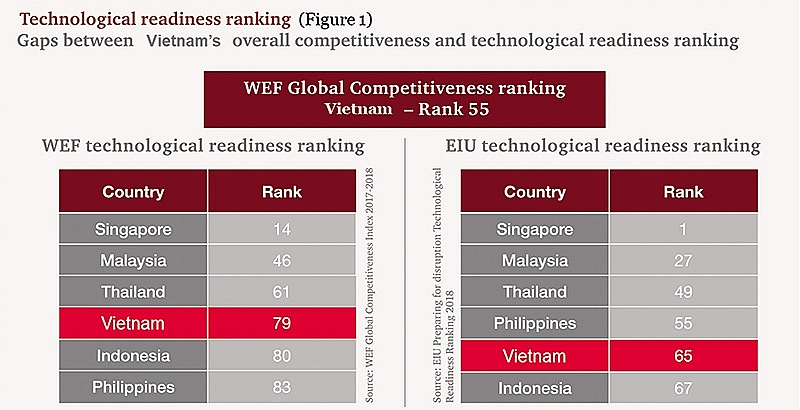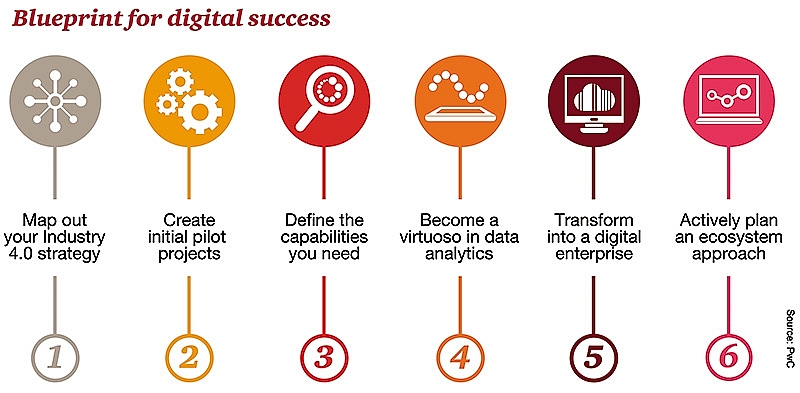Keeping your business ahead in the digital age
 |
| Grant Dennis |
Obstacles for ASEAN and Vietnam
Fifty years after its establishment, the ASEAN has become one of the fastest-growing and most dynamic regions in the world. The region is still expected to outperform average global growth and is estimated to expand by 5.3 per cent in 2018, led by emerging economies such as Vietnam, which is projected to grow by 6.9 per cent, according to the Economic Outlook by the Organisation for Economic Co-operation and Development (OECD). However, new technologies such as the Internet of Things, advanced robotics, and artificial intelligence (AI) could threaten this growth story in the longer term – unless ASEAN markets start preparing themselves for the shift.
The ASEAN’s core value proposition, low labour costs, will fade away over the coming decades, as protectionist sentiments and new technologies rise. These factors will keep more production within the shores of the developed parts of the world.
Moreover, there is still a gap between Vietnam and other ASEAN countries in terms of technology readiness, according to the World Economic Forum’s Global Competitiveness Index 2017-2018 and the Economist Intelligence Unit’s Technological Readiness Ranking 2018 (see Figure 1). It is imperative for Vietnam to embrace digital change instead of relying on its key advantage of low labour costs.
 |
| Keeping your business ahead in the digital age |
 |
| Keeping your business ahead in the digital age |
Business strategy for the digital age
It is a common misconception that successful Industry 4.0 businesses will focus heavily on technology by ‘going digital’. Digital is not a ‘strategy’, it is a ‘business strategy’ for the digital age. Business leaders should look at this task with a comprehensive view, bringing business together from three dimensions simultaneously, from the business strategy, customer experience, and technology (BXT) areas of focus and work.
Here are six steps that have been critical for successful companies, according to the research of PwC’s digital transformation experts (see Figure 2):
1. Map out an Industry 4.0 strategy up front. Business leaders are advised to evaluate their own digital maturity and determine new targets for closing any gap.
- How well are they using the data and analytics available to them?
- How skilled are their people and where do they need to focus on up-skilling or re-skilling?
- How digitally change-ready are their business operating models and processes?
Leaders should prioritise the measures which bring the most value to the business for their overall strategy. This includes aligning the business and customer needs with existing and emergent technological capability required to support delivery. Great client experiences start with a great employee experience and deep insight into your digital customer segments, as opposed to the traditional segmentation. Gaining commitment to this approach from the entire company leadership, making their commitment to customers evident to every employee, and inviting staff to take part in creating the new model wherever possible is key.
2. Start with pilot projects. Experiments are necessary to establish proof of concept and demonstrate business value. Not every project will succeed, but they will all help the leaders learn the approach that works for their company. Learning should be a measured outcome and make its way into key performance indicators. Based on successful experiments, they can also gain buy-in from the organisation and secure funding for a larger rollout. For early pilot projects, businesses should start with a relatively narrow scope, but incorporate the end-to-end concept of Industry 4.0 – from materials to customer delivery and after-sale services. These pilots are also an opportunity to test collaboration with digital leaders outside the company’s boundaries, including working with startups, universities or industry organisations to accelerate digital innovation.
3. Define the necessary capabilities. By building on the lessons learned in these pilots, business leaders can map out in detail the capabilities required to achieve their ultimate goals, as well as develop a blueprint for building, acquiring or partnering with those capabilities. Businesses should build up technological enablers, such as an agile and highly functional IT infrastructure with well designed, user-friendly interfaces that can propel business processes forward. Success with Industry 4.0 will depend on the speed and clarity with which a business can respond to changing customer expectations and the technical integration of the full supply and production chain, including the automation of the commercial and trade finance supply chains. Thus, business leaders should include strategies for recruiting and developing employees who can unlearn and relearn quickly and attracting partner companies who are equally responsive to work with.
4. Become an expert in data analytics. Success with Industry 4.0 further depends on the ability to unlock the power of data and use analytics in effective ways. Taking a holistic approach to the use of all data available, structured and unstructured, such as social media, to find unforeseen connections and insights is yet another road to digital innovation. This involves building cross-functional analytics capabilities that serve the strategic priorities of the enterprise, drawing on in-house staff and outsourced expertise. By developing ways of combining data from different parts of the business (e.g. quality, logistics, and engineering functions) with data sourced from external partners, companies can make themselves stand out or attract new customers. Business leaders will get even more value out of data by using real-time analytics to tailor products to customers and continually improve business processes.
5. Transform into a digital enterprise. Transforming under Industry 4.0 results in major changes to business practices and the attitudes underlying them, for example, shifting from product-centric to customer-centric, from responding to needs to pre-empting them, from operational analytics to predictive analytics. Vertically organised businesses need to turn their organisational charts sideways to create cross-functional, omni-channel, journey-based activity. The customer journey becomes the central value chain and to support all these new ways of thinking and working, physical office spaces also need to be reshaped. Business leaders must set the tone from the top, with clear leadership, vision, and commitment from other C-suites and financial stakeholders. They should create a digitally fit culture where all employees consider BXT in every activity, and are willing to experiment, learn, and adapt. Change does not stop once Industry 4.0 strategies are implemented. The company will need to reinvent its capabilities continually to stay ahead of the game.
6. Adopt an ecosystem perspective. Companies should actively seek partnerships or use external platforms where it is not sensible for the business to develop a comprehensive offering of products and services on their own. It might be difficult to share knowledge with other companies and there may be a preference for acquisition over collaboration, but business leaders have to look for ways to bridge their own company’s boundaries. The greatest breakthroughs in performance occur when a company actively understands consumer behaviour and can create a distinctive role for itself within a complex ecosystem of partners, suppliers, and customers. Often, tech startups are focusing on niche markets and segments and manufacturing technologies that larger companies or government departments cannot, so partnering with these smaller entities can accelerate the development of new Industry 4.0 plays and initiatives.
In summary, business transformations, either incremental and fast or one major change, are inevitable with the advent of Industry 4.0. Business leaders in Vietnam are clearly required to make comprehensive preparations for the transition to a digital age. Local organisations are well advised to beat the rush by seeking expert recommendations now on what they could do to optimise the opportunities brought about by Industry 4.0.
By Grant Dennis, Consulting Services leader, PwC Vietnam
What the stars mean:
★ Poor ★ ★ Promising ★★★ Good ★★★★ Very good ★★★★★ Exceptional
Related Contents
Latest News
More News
- Driving double-digit growth through green and circular transformation in Vietnam (December 17, 2025 | 09:00)
- Vietnam bucking trend in the global M&A landscape (December 16, 2025 | 14:20)
- Vietnam’s green transition demands collective financial action (December 15, 2025 | 12:00)
- VIR workshop highlights capital and policy for sustainable development (December 15, 2025 | 11:00)
- National Assembly approves pilot mechanisms to accelerate major projects in Hanoi (December 12, 2025 | 11:29)
- Vietnam eases policy approval requirements, simplifies foreign and outbound investments (December 11, 2025 | 17:53)
- Unpacking new momentum in Vietnam’s M&A market (December 10, 2025 | 09:59)
- Forum honours outstanding M&A deals, strategies, and advisory firms (December 09, 2025 | 18:22)
- Vietnam enters defining phase of M&A growth (December 09, 2025 | 17:00)
- Vietnam’s M&A market opens new opportunities amid strong economic momentum (December 09, 2025 | 15:00)

 Tag:
Tag:






















 Mobile Version
Mobile Version